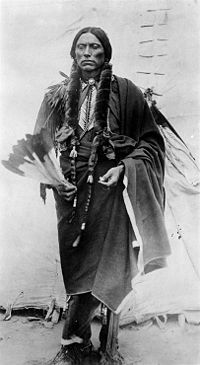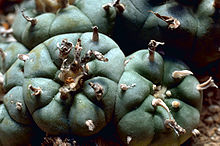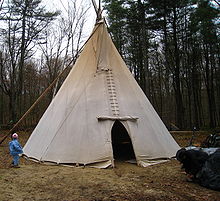- Native American Church
-
Native American Church, a religious denomination which practices Peyotism or the Peyote religion, originated in the U.S. state of Oklahoma, and is the most widespread indigenous religion among Native Americans in the United States. Peyotism involves the use of the entheogen Peyote, a spineless cactus.
Contents
History of the peyote religion
Peyote was used in the territory of modern Mexico in pre-Columbian times to commune with the spirit world and also as a medicine. From the mid-15th century, the use of peyote spread to the Great Plains area of the United States primarily through the efforts of the Apache, Navajo, Plains Tribes, and various tribes in the western United States. Peyotism is now practiced in more than 50 Native American tribes and has probably around 250,000 adherents.[1][2]
Peyotist beliefs vary considerably from tribe to tribe, belief in Peyote personified as a god called Mescalito by some practitioners, but often include belief in Jesus as a Native American culture hero, an intercessor for man or a spiritual guardian; belief in the Bible; and association of Jesus with Peyote. Peyotists believe in a supreme God. The "Peyote Road" calls for Native American brotherly love (often taking the form of Native American nationalism), family care, self-support through work, avoidance of alcohol, and avoidance of recreational drug use.
Traditionally, peyote is used in pursuit of bona fide religious faith in daily ceremonies, and at all times. Peyote rituals can be conducted by oneself and with the Creator, or with a guide, or in a group, and at any place or time the Spirit or Creator and the participant deem them necessary. Peyote ceremonies are not conducted only in tipis or hogans however, in some cases ceremonies may be limited to a certain number of people but this varies from tribe to tribe.
For some chapters of the Native American Church, the peyote ritual begins at sundown on a Saturday and continues through the night. The ritual includes prayer, the eating of peyote, Peyote songs, water rituals, and contemplation. It ends with breakfast Sunday morning. The peyote ritual is believed to allow communion with Holy deity or spirits, and to give power, authority, guidance, and healing. The healing may be emotional or physical, or both.
Those Church members who feel that they need structure believe that the communal ingestion of peyote and the ceremony of the Church meeting help participants get into a proper relationship with each other and with the Holy deity or spirits. In turn, they believe, this leads to an ability to live a good day-to-day life. A good life is considered to be one that is kind and responsible, and embodies harmony.
United States law
Federal law
As a result of the U.S. Supreme Court decision in Employment Division, Department of Human Resources of Oregon v. Smith, 494 U.S. 872 (1990), which, among other things, put the legal use of peyote by American Indians into uncertainty and potential legal jeopardy, Congress passed an amendment to the American Indian Religious Freedom Act of 1978 (42 U.S.C. § 1996), i.e., the American Indian Religious Freedom Act Amendments of 1994 (42 U.S.C. § 1996a), pertinent excerpts of which are given below:
“Use, possession, or transportation of peyote Notwithstanding any other provision of law, the use, possession, or transportation of peyote by an Indian for bona fide traditional ceremonial purposes in connection with the practice of a traditional Indian religion is lawful, and shall not be prohibited by the United States or any State. No Indian shall be penalized or discriminated against on the basis of such use, possession or transportation, including, but not limited to, denial of otherwise applicable benefits under public assistance programs.”
42 U.S.C. 1996A(b)(1).
“Definitions
For purposes of this section— (1) the term “Indian” means a member of an Indian tribe; (2) the term “Indian tribe” means any tribe, band, nation, pueblo, or other organized group or community of Indians, including any Alaska Native village (as defined in, or established pursuant to, the Alaska Native Claims Settlement Act (43 U.S.C. § 1601 et seq.)), which is recognized as eligible for the special programs and services provided by the United States to Indians because of their status as Indians; (3) the term “Indian religion” means any religion— (A) which is practiced by Indians, and (B) the origin and interpretation of which is from within a traditional Indian culture or community; and (4) the term “State” means any State of the United States, and any political subdivision thereof.”
42 U.S.C. 1996A(c)
“Protection of rights of Indians and Indian tribes
Nothing in this section shall be construed as abrogating, diminishing, or otherwise affecting— (1) the inherent rights of any Indian tribe; (2) the rights, express or implicit, of any Indian tribe which exist under treaties, Executive orders, and laws of the United States; (3) the inherent right of Indians to practice their religions; and (4) the right of Indians to practice their religions under any Federal or State law."
42 U.S.C. 1996A(d)
Accordingly, the lawful use of Peyote in the United States is limited to “Indians” who are members of “Indian Tribes”. Contrary to other erroneous decisions in various courts and even previous posting here, the existing legal exemption for Indians is only for Indians and Indian Tribes, and not for anyone else who professes similar, if not identical, religious beliefs. This exemption for Indians does not violate the First Amendment to the United States Constitution, nor does it violate the Equal Protection Clause of the Fourteenth Amendment. Morton v. Mancari, 417 U.S. 535 (1974). This is because of the unique political status of American Indians as members of sovereign nations and the plenary power of Congress over “Indian tribes”. Art.1, Sec. 8, Cl. 3. Constitution of the United States of America. It is the unique political status of Indians that is paramount in this context and political status is not a racially based classification.
State law
Currently, laws regulating peyote use by Native American Church members vary by state.
The Native American Church Movement
 Quanah Parker clasping a peyote feather fan
Quanah Parker clasping a peyote feather fan
Quanah Parker was an influence in the creation of the Native American Church. The movement started in the 1880s, and was formally incorporated in 1918 in Oklahoma. Parker adopted the peyote religion after being gored by a bull in South Texas and surviving the attack with the help of peyote.[citation needed] Parker was given strong peyote tea by a Coahuiltecan Native American curandera who healed him and showed him the proper way to run peyote ceremonies. Therefore, the genesis of modern NAC ceremonies have deep roots in Mexican Native American culture and ritual, due to the natural locality of Peyote and the dissemination by Parker to the Comanche and other plains tribes located in Indian Territory.[3][4]
Parker taught that the Sacred Peyote Medicine was the Sacrament given to all Peoples by the Creator, and was to be used with water when taking communion in some Native American Church medicine ceremonies. Parker learned the "half-moon" style of the peyote ceremony from the Lipan Apache leader Chiwat. The Lipan Apache learned the ceremony from the Carrizo Coahuilteco tribe of Southern Texas(Peyote Religion by Omer Stewart). The "cross fire" ceremony (originally called the "Big Moon" ceremony) later evolved in Oklahoma (initially among the Kiowa Native American) due to influences introduced by John Wilson, a Caddo Native American who traveled extensively around the same time as Parker during the early days of the Native American Church movement.
The Peyoteros of South Texas
The peyote religion evolved an elaborate trade network which has persisted since pre-Columbian times, in South Texas, with designated harvesters of the peyote in Rio Grande City, Texas, and Mirando City, Texas. The Peyoteros are a group of closely knit families of Mexican ancestry who have harvested peyote for Native Americans since the early 18th century. The modern peyoteros still harvest peyote in the same manner as their ancestors, with a machete and a very small work crew of young and sometimes old men. Peyote is harvested and dried after the crowns of the plants are removed at ground level; cut at an angle, to allow water to run off. The peyoteros never dig up peyote, but rather cut the tops of the cactus crowns at ground level with a machete. Peyote plants create large taproots with an extensive root system, and the plants slowly regenerate new heads after harvest, often producing a much larger plant after several years of regrowth. Currently, Peyote is being overharvested, seriously endangering the existence of the local populations of peyote. There are only 3 licensed Peyoteros left in Texas due to overharvesting, illegal poaching, and strict licensing and tax regulations by the Texas Department of Public Safety and the U.S. Federal government. Two Peyoteros in South Texas are Mauro Morales of Rio Grande City, Texas, and Salvador Johnson of Mirando City, Texas.
Native American are permitted to purchase peyote to supply the Native American Church both in person and via US Mails "Restricted Delivery" procedures. Special ceremonies are performed with the harvested and dried peyote medicine in order to bless it for use as a sacrament for Native American Church rituals and ceremonies.
All three of the peyoteros are licensed by the United States Drug Enforcement Agency and operate under DEA 225 permits. Peyoteros are also required to be registered with the State of Texas Department of Public Safety, for a fee over $1,200 per year in a poverty stricken area of south Texas. Legitimate Native American Church Branches are required to register with the Texas Department of Public Safety in order to purchase, harvest, transport, or cultivate peyote. Non-Native American churches not affiliated with Federally Recognized Tribal entities are not eligible for registration with the Texas Department of Public Safety at this time.
See also
- Employment Division v. Smith
- Freedom of thought
- Hair drop, Native American Church regalia
- Indigenous peoples of the Americas
- The red road
References
- ^ "University of Virginia Library". Religiousmovements.lib.virginia.edu. 2006-09-07. http://religiousmovements.lib.virginia.edu/nrms/nachurch.htm. Retrieved 2011-07-09.
- ^ "'A Brief History of the Native American Church'". CSP. http://www.csp.org/communities/docs/fikes-nac_history.html. Retrieved 2011-07-09.
- ^ Stewart OC. 1989. Peyote Religion: A History. Norman, OK: University of Oklahoma Press. ISBN 0806124571.
- ^ Alice Lee Marriott, Carol K. Rachlin, Peyote: An Account of the Origins and Growth of the Peyote Religion, New York: Thomas Y. Crowell Co. (1971), 111pgs.
External links
- Native American Church
- Native American Church of Strawberry Plains Tennessee
- Listing of Native American Churches
- Peyote Way
- American Ethnography – The use of Peyote by the Carrizo and Lipan Apache tribes
- American Ethnography – A description of a Tonkawa peyote meeting held in 1902
- – colorado branch of oklevueha N.A.C.
Categories:- Christian denominations, unions, and movements established in the 19th century
- Indigenous Christianity
- Native American Church
- Religious organizations established in the 1890s
- Religious organizations using entheogens
Wikimedia Foundation. 2010.





